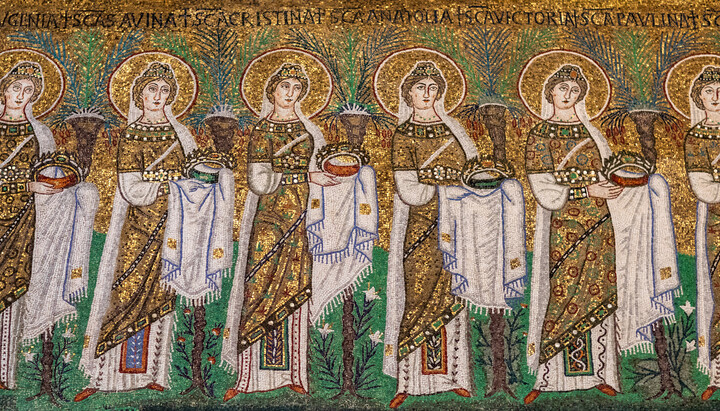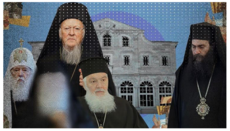The Myth of the 'Female Diaconate'

The St. Phoebe Center for the Deaconess was denied a booth at the OCA's All-American Council. They claim that an ordained female diaconate is part of "our tradition" as Orthodox Christians. But they're wrong. Deaconesses were not “ordained” in the modern sense of the term; therefore, they were not “deacons” in the modern sense of the term. The OCA's response—a gentle but firm refusal even to discuss this error—is the right one.
The Orthodox Church of America held its biannual All-American Conference in Phoenix, AZ, this past July. In the months leading up to the AAC, the St. Phoebe Center for the Deaconess applied for a table in the exhibit hall. As their name implies, the St. Phoebe Center is an activist group that supports the ordination of women to the diaconate.
In a September 23 email to their supporters, the St. Phoebe Center explains that their application was denied. When they appealed to Met. Tikhon, the OCA’s primate, they received the following reply:
There is no official forum of the Orthodox Church in America suitable for the St. Phoebe Center's education and advocacy for the restoration of the female diaconate, as the Holy Synod has not initiated and blessed such a conversation touching on the Church's doctrine and practice.
At the AAC itself, a lay delegate asked the Holy Synod if they would consider “reviving” the female diaconate. According to the St. Phoebe Center, Met. Tikhon said that the Synod would not entertain the possibility, because it was “not handed down to us.” The email then says, “The audience acknowledged his comments with a round of applause.”
Multiple UOJ sources at the All-American Council recount the events somewhat differently. They said that the delegate’s question about the female diaconate was met with boos. What’s more, the audience didn’t merely “acknowledge” His Beatitude’s comment but received them warmly with thunderous applause.
In any event, the St. Phoebe Center complained that Met. Tikhon’s response was not only inappropriate but inaccurate. In the email of September 23, they write:
The possibility of ordaining women as deaconesses today is not a “doctrinal” question, considering that our tradition included deaconesses as part of its practice for centuries and the order has never been banned. The question of ordaining women to the diaconate today is an exclusively pastoral question.
With all due respect, this is simply incorrect.
To speak of women being “ordained” to the diaconate is anachronistic. It’s true, the term ordination was at times used to describe the conferral of the diaconal office upon women. In the first centuries of the Church, however, “ordination” was not yet synonymous with sacramental ordination.
Severus of Antioch (5th c.) makes this clear in a letter he wrote during his exile. His correspondent complained that no deaconesses could be ordained at a certain convent because there was no bishop available. Severus assured his correspondent not to worry. “In the case of deaconesses,” he wrote, “ordination is performed less in regard to the needs of the mysteries than exclusively with regard to doing honor.” He went on to say that, “In the cities, deaconesses habitually exercise a ministry relating to the divine bath of regeneration in the case of women who are being baptized.”
The compiler of the Apostolic Constitutions (4th c.) does specify that deaconesses are “ordained” by the imposition of hands. However, as Aime Georges Martimort points out in study on the female diaconate:
The text of this unusual prayer of institution does not appear to have been actually used anywhere. Was it the artificial creation of our author/compiler? Or was it actually used in a local church somewhere? It is very difficult to say. Because of the fact that its actual use did not spread anywhere, I would be inclined to attribute it to the author/compiler.
Even if it could be definitely established that, in some local church deaconesses were ordained by the imposition of hands, it would make little difference. Firstly, this would not necessarily imply sacramental ordination. Secondly, it would simply stand as the “exception that proves the rule.” And the rule is this: the first Christians were careful to establish that deaconesses did not belong to the same order as bishops, priests, and male deacons.
Hippolytus of Rome (2nd c.) expressly forbade the laying on of hands as part of the “ordination” of deaconesses. On the contrary, he almost dismissively writes:
No other category of clergy is allowed to carry out the function of the deacon. The deaconess does not give blessings; in fact, she does nothing that the priests and deacons do. All that she does is watch the doors and carry out her ministry assisting the priests in the baptism of women for the sake of decency and decorum.
What does this mean, “for the sake of decency and decorum? This is made abundantly clear in the Didascalia Apostolorum (3rd c.).
The Didascalia calls for the ordination of deacons: “on the one hand, a man for the administration of the many necessary tasks; on the other hand, a woman for the ministry among the women.” Clearly, the two are grouped together because they share a name. At the same time, the compiler takes great pains to emphasize how very different their roles are.
The Didascalia specifies the “gendered” nature of the diaconesses’ ministry:
In the first place, when women go down into the water, it is necessary that those going down into the water be anointed with the [chrism] by a deaconess. Where no other woman is present, especially where no deaconesses are present, it will then be necessary that the one who is conducting the baptism must anoint the woman being baptized, but they should then be anointed only on their heads.
Now, for those who don’t know, men and women were baptized naked in the Early Church. Their entire body was also anointed with holy oil. Priests and male deacons couldn’t perform this task for female catechumens, for obvious reasons. The role of the deaconess, then, was less sacerdotal than practical. Her role was not integral to this or any other divine service.
The Didascalia concludes:
When the woman who has been baptized comes out of the water, the deaconess should receive and instruct and educate her so that the unbreakable seal of baptism will be preserved in holiness and purity. For this reason, we assert that the ministry of a female deacon is especially required and urgent.
So, in addition to assisting at baptisms, the deaconess is also called to mentor newly baptized Christian women. This, according to the Didascalia, is the reason for the female diaconate.
Indeed, as we survey the history of the female diaconate, three facts become clear. First, the deaconess’s role was highly “gendered.” Secondly, it was extremely limited, in no way comparable to the male diaconate—much less the priesthood. Thirdly, it existed to accommodate for norms and practices which no longer exist in the modern Church.
For instance, the Testamentum Domini (4th c.) says that deaconesses are “to be stationed near the principal doors of the church.” They are permitted to stand behind the iconostasis at the Proskomide; however, they are required to stand behind the subdeacons. Whatever else may be said, there is no sense that they were equal to male deacons. Also, they were not permitted to commune with the clergy. Rather, they were the first women to receive Holy Communion following the male laity.
The canons of Basil the Great (4th c.) refer to deaconesses. However, the punishment they describe for grave infractions is excommunication, while clergy—bishops, priests, and deacons—are to be punished by defrocking. This is taken from the principle laid out in Nahum: “He will not take vengeance twice on his foes.” In other words, to defrock and excommunicate a clergyman would be seen as excessive. In other words, deaconesses were punished in the same manner as the laity, not the clergy.
Epiphanius of Salamis (4th c.), in his Exposition of the Catholic Faith, says the following: “Deaconesses are instituted solely for service to women, to preserve decency as required, whether in connection with their baptism or in connection with any other examination of their bodies.”
Pseudo-Dionysius the Areopagite (5th c.) does not refer to female deacons in his authoritative Ecclesiastical Hierarchies.
We could go on. However, I believe this is sufficient to establish that the St. Phoebe Center is in error. The “question of ordaining women to the diaconate today” is not a “pastoral question.” The statement, that “our tradition included deaconesses as part of its practice for centuries," is, at best, misleading. Deaconesses were not “ordained” in the modern sense of the term; therefore, they were not “deacons” in the modern sense of the term.
Of course, there would be an argument for bringing back the diaconate if we reinstituted a number of ancient practices which made the position necessary. We could return to the custom of nude baptism, of sex-segregated seating, of communing men before women, etc. Yet, somehow, I don't think feminists would consider this a victory.
Indeed, it's because Christians gradually embraced a more egalitarian view of sex and gender that the office of deaconess became redundant. The disappearance of female deacons is, paradoxically, a sign of progress both within the Church and in society at large.
In any event, Met. Tikhon and the Holy Synod of the Orthodox Church of America are absolutely correct: the female diaconate as described by the St. Phoebe Center is not part of our tradition, nor has it ever been. Orthodox Christians everywhere should be grateful for their wise and decisive defense of the Holy Tradition in this time of great uncertainty.









